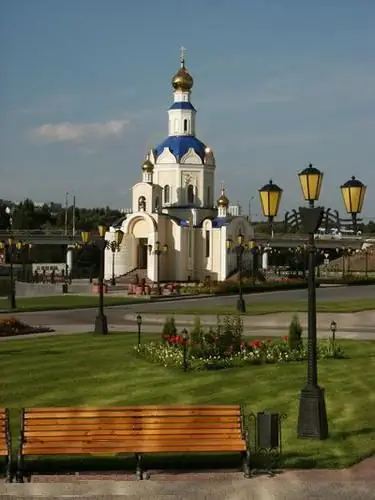- Author Harold Hamphrey [email protected].
- Public 2023-12-17 10:06.
- Last modified 2025-01-24 11:10.
Debrecen is the second largest city in Hungary. Among our tourists, it is far from being as popular as Budapest, but it also has its own charms. People come here to relax from the hustle and bustle and improve their he alth at the thermal springs.
Debrecen
By European standards, Debrecen in Hungary is quite a large city. It is home to approximately 200 thousand people. According to one version, its name is translated as "good benefit", according to another - it comes from the Slavic word "dobrochin".
It was first mentioned in 1235, but, in fact, the city is much older. In the 15th century, it became a developed trading center. Markets were organized here, fairs were held. In the 19th century, the city was at the center of the Hungarian Revolution, in fact, turned into the capital of the state. Its inhabitants remember history and are always proud to be born in Debrecen in Hungary.

Reviews from tourists are also positive. The city leaves a pleasant feeling and hospitably welcomes visitors. Debrecen is located 215 kilometers from Budapest. A highway and a railway pass through it, which connect the capitalHungary and the Ukrainian cities of Chop and Uzhhorod. It is also connected to the Romanian city of Oradea.
It can also be called the "capital of Hungarian football". The local football club "Debrecen" is the strongest in the country. He took part in European cups many times and became the champion of Hungary six times in a row (from 2005 to 2010).
Sights of Debrecen
Hungary has experienced many turbulent historical events, of which Debrecen also became a part. During World War II, half of the city was destroyed to the ground. But some architectural monuments still survived.
In Debrecen in Hungary there are several interesting objects, for example, the city university, the Red Church, the Reformed Cathedral, the Big Forest park, the building of the Golden Bull Hotel. A gloomy, but no less worthwhile place is the public cemetery, which is more of a sculpture park. You can get acquainted with historical architecture while walking along Rynochnaya Street, Bösermeni and other central arteries.
You can stay in the city in one of the hotels. In Debrecen, Hungary, there are a huge number of them, and most of them are kept at a high level. One of these places is the Wellness Hotel, which is located right next to the baths and the water park. Divinus, Gondola, Villa Hotel, Lycium Debrecen have long earned the reputation of high-class hotels. More budget hotels are Korona, Izabella Panzio, Peterfia Panzio, Aranybika, KLK Hotel.
Thermal baths
The main reason people visit Debrecen in Hungary is the thermalsources. Baths "Nadyerdo" in the "Big Forest". The first of them was founded in 1826. They are part of the huge Aquatikum complex.
Here there are thermal pools, steam rooms, cave baths and corridors with currents. The complex is interesting not only for adults, but also for children. It has a water park with a dozen slides and children's pools. Massage rooms and Jacuzzis are available for adults.

Local water contains chlorine, bromine, sodium, iron, calcium, metaboric and metasilicic acids, iodides, sulfates, phosphates and other substances. The water temperature is +63 degrees. The baths treat neuralgia, diseases of the joints and spine, paralysis, respiratory diseases and disorders in the female reproductive system, ankylosing spondylitis.
Reformed Church
The Big or Reformed Church is one of the main sights of Debrecen. In Hungary, it is known for the fact that it was in it that in 1849 the revolutionary Lajos Kossuth declared the independence of the country. The chair in which he read the declaration is still in the cathedral.

The style of the church combines several styles. The first two floors are made in strict classicism with a wide pediment and Ionic columns. Above them rise two symmetrical baroque towers. They rise up to 60 meters in height. The Grand Cathedral of Debrecen seats about 5,000 people and is the largest Protestant church in the country.
Debrecen University
The university in Debrecen in Hungary is the largest in the city and one of the leading in the country. More than 30 thousand students study in it, not only from Hungary, but also from other countries of the world. The university has a faculty of computer science, medicine, art, science, sports, law, agriculture and humanities.

It was founded in 1538 as a Calvinist college. It became a higher educational institution only in the 20th century. The main building looks restrained and at the same time majestic, which resembles a palace. This is a gray building with a red roof, next to which is a botanical garden. The area in front of the main entrance is decorated with alleys, flower beds and fountains. Anyone can walk here, but the entrance to the building is open only on weekdays from 9 am to 1 pm.
Hortobágy National Park
40 kilometers from the city is the largest national park in Hungary. Hortobágy is 820 km2 of flat steppes and solonchaks. For a long time, local residents used its territory for grazing, and during the Soviet period, 12 concentration camps were located here.
Now the park is a world cultural heritage and is under the protection of UNESCO. It is inhabited by buffaloes, goats, sheep, Hungarian bulls and many birds. In summer, the weather in the park is dry and hot, so tornadoes and mirages can often be observed in it.

In 1883, a long bridge with nine arches was built over one of its swamps, stretching 167 meters. Next to it is an inn. It was founded three hundred years ago, when the S alt Road from Buda to Transylvania ran through this area. Now they have made an ethnographic exhibition there.






